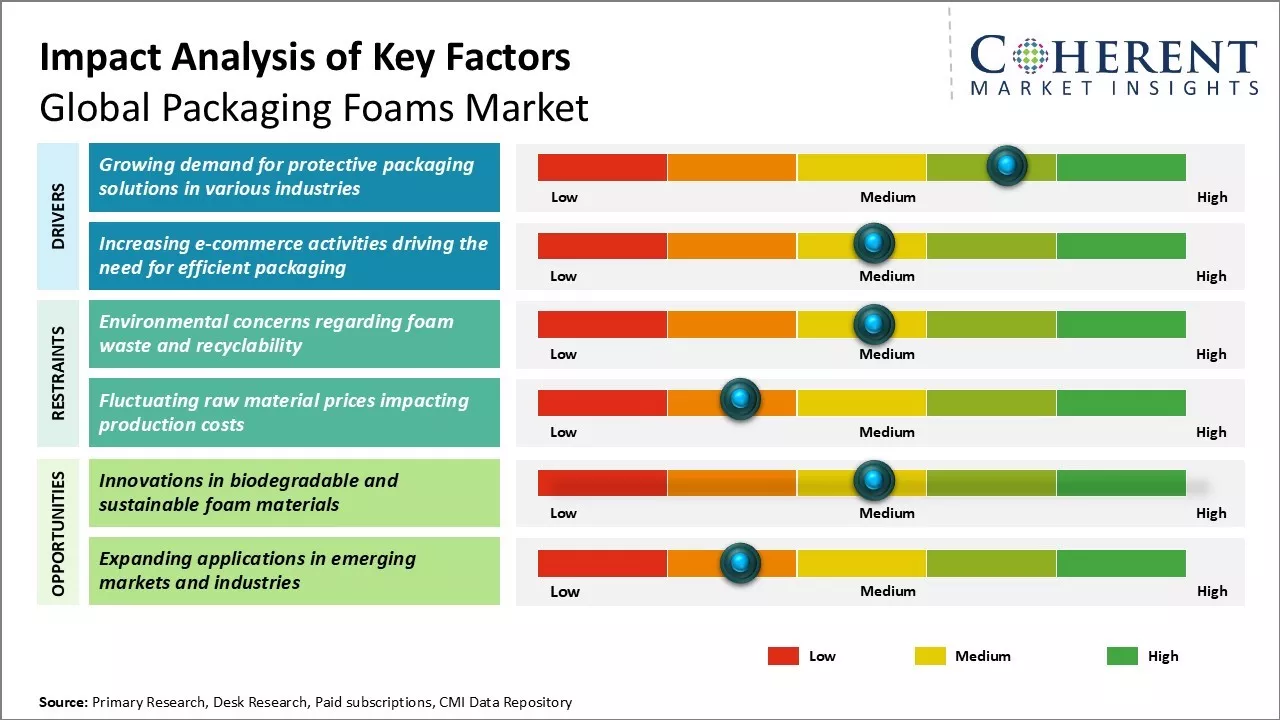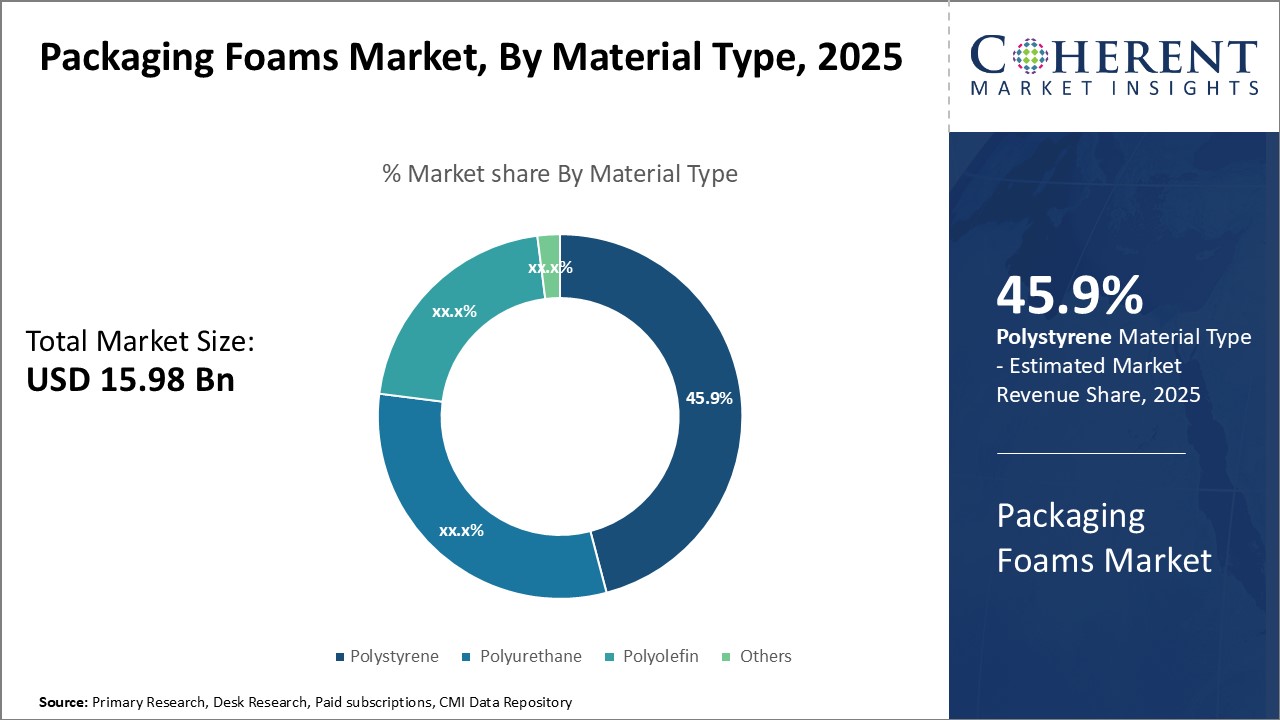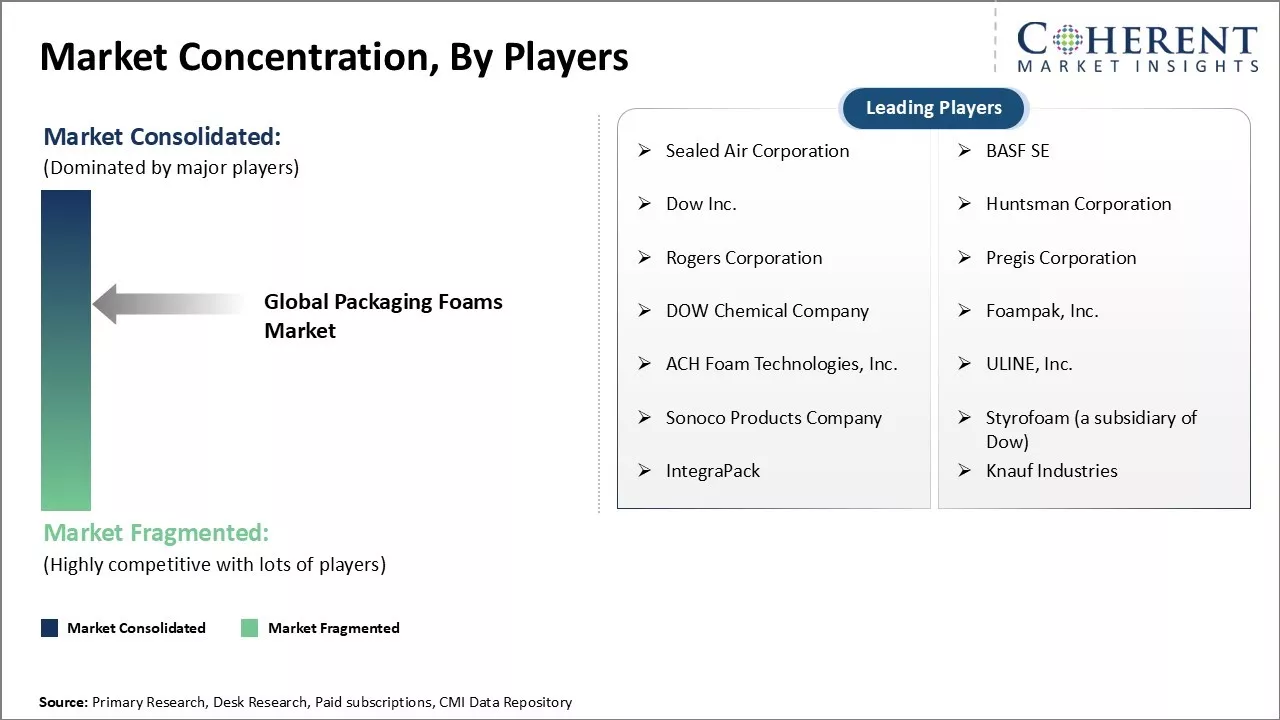The global packaging foams market is estimated to be valued at USD 15.98 Bn in 2025 and is expected to reach USD 25.34 Bn by 2032, exhibiting a compound annual growth rate (CAGR) of 6.8% from 2025 to 2032.

Discover market dynamics shaping the industry: Download Free Sample
Packaging foams like expanded polystyrene, polyurethane, and polyethylene find widespread applications in numerous end-use industries such as food and beverages, consumer goods, healthcare, and others. Foams' properties such as lightweight, resistance to shock & vibration, and cushioning make them suitable for packaging various products. The market is expected to witness positive growth over the forecast period supported by increasing demand from fast moving consumer goods and food and beverage industries. Growing e-commerce sector necessitating effective packaging solutions is further expected to drive the market growth.

Discover high revenue pocket segments and roadmap to it: Download Free Sample
Insights By Material Type - Superior Properties Drive the Polystyrene Demand
In terms of material type, the polystyrene segment is expected to contribute 45.9% share of the market in 2025, owing to its superior protective properties. Polystyrene foam is widely used for protective packaging applications due to its ability to withstand shocks and impacts without damage. It protects products from abrasions, punctures, and deformation during shipping and transportation. Polystyrene foam cushioning provides protection that exceeds fiberboard or corrugated cardboard alone.
Insights By Structure - Flexibility Drives the Demand for Foam Packaging
In terms of structure, the flexible foam segment is expected to contribute 56.9% share of the market in 2025, owing to advantages in conformability and form stability. Flexible foam conforms closely to the shape of products during the packaging process, reducing wasted void spaces, and making efficient use of transport and storage volumes. It molds tightly to any object without tearing. This allows flexible foams to conform to irregularly shaped goods, providing protection from all angles.
Insights, By Application - Food Safety Drives the Foam Demand in Food Packaging
In terms of application, food packaging segment is expected to contribute 41% share of the market in 2025. This can be attributed to foam packaging's advantages in ensuring food safety and extending shelf life. Foams used for food packaging create an effective barrier against moisture, gases, light, microbes, and external contaminants. This is critical for preventing spoilage and keeping food fresh for longer. Foam wraps and liners in food containers and boxes provide an extra layer of protection during transport compared to single-walled packaging.

Need a Different Region or Segment? Download Free Sample
Dominating Region: Asia Pacific
The Asia Pacific region is expected to dominate the market in 2025, accounting for 34.8% of the market share. This leadership is driven by the strong presence of key players such as Fagerdala and Zotefoams. Regional government efforts to promote sustainability and minimize packaging waste have further fueled the adoption of lightweight, durable foam-based solutions across sectors including food and beverages, consumer goods, and pharmaceuticals.
Fastest-Growing Region: North America
North America exhibits the fastest growth riding on the back of rapid industrialization and growing export activities across countries like the U.S. and Canada. Establishment of manufacturing facilities by international brands such as Whirlpool Corporation and expansion of e-commerce have significantly boosted the demand for protective foam packaging in the region.
Packaging Foams Market Outlook for Key Countries
Fostering Growth and Sustainability: The U.S. Market for Packaging Foams
The U.S. holds a substantial share of the protective foam packaging market, driven by its advanced industrial base and extensive e-commerce activities. This demand spans sectors such as electronics, automotive, and food and beverages, where protective packaging is essential. However, increasing environmental regulations and a growing consumer preference for sustainable packaging solutions are prompting a shift towards eco-friendly foam alternatives. A key contributor to this shift is Sealed Air Corporation, a prominent U.S.-based packaging company known for brands like Bubble Wrap and Cryovac. Sealed Air has prioritized sustainable protective packaging by offering innovative solutions that align with both packaging needs and sustainability goals.
China Packaging Foams Market: Industrial Growth and the Push for Sustainability
China dominates the Asia Pacific packaging foams market, primarily due to its expansive manufacturing sector and burgeoning e-commerce industry. The country's packaging foams market benefits from the growing food and beverage, automotive, electronics, personal care, and pharmaceutical industries. For instance, according to the National Bureau of Statistics of China, in 2021, the food industry in China generated a total profit of about (USD 86.33 billion). This industrial growth fuels the demand for packaging foams. However, increasing environmental concerns and government regulations are pushing manufacturers towards sustainable packaging solutions.
Japan Packaging Foams Market: Innovation and Sustainability at the Forefront
The Japan packaging foams market is characterized by technological advancements and a strong focus on sustainability. The country's mature electronics and automotive industries drive the demand for high-quality packaging foams. Additionally, Japan's commitment to environmental conservation has led to the development and adoption of eco-friendly foam materials. A notable contributor in this sector is TECHNO FOAM JAPAN CO., LTD., a subsidiary of INOAC Corporation. Specializing in the processing and sales of polyurethane and rubber products, TECHNO FOAM JAPAN focuses on eco-friendly production activities and offers value-added products by incorporating new effective processes into functional materials.
Canada Packaging Foams Market: Balancing Growth and Sustainability Goals
In Canada, the packaging foams market is witnessing steady growth, driven by the country's robust e-commerce sector and the need for protective packaging solutions. The Canadian government's emphasis on sustainability is encouraging the adoption of eco-friendly foam materials. However, stringent environmental regulations and the availability of alternative packaging materials pose challenges to market expansion. The government plans to mandate that plastic packaging contain at least 50.5% recycled content by 2030, aiming to strengthen end-markets for recycled plastics and reduce plastic waste.
India Packaging Foams Market: Growth Driven by Industrialization and Sustainability Initiatives
India is emerging as a significant player in the packaging foams market, propelled by rapid industrialization, urbanization, and a thriving e-commerce sector. The country's expanding food and beverage, electronics, and automotive industries contribute to the growing demand for packaging foams. Government initiatives such as National Strategy to Prevent Plastic Pollution promoting sustainable packaging are encouraging the use of biodegradable and recyclable foam materials. A notable contribution in this field comes from researchers at the Indian Institute of Science (IISc) in Bengaluru. They have developed an innovative biodegradable foam derived from non-edible oils and tea leaf extracts, offering a sustainable alternative to traditional plastic packaging.

Get actionable strategies to beat competition: Download Free Sample
Top Strategies Followed by Global Packaging Foams Market Players
Emerging Startups in the Global Packaging Foams Market
Innovative Technologies: Companies like Storopack and Connecting Air have developed smart cushioning materials that can replace conventional plastic bubblewraps and Airex foam sheets. By leveraging nanotechnology, these startups provide tunable cushioning with self-healing properties and edge-protect features, reducing material usage.
Sustainable Solutions: Startups like Suiteable and Devoted Resources focus on creating foams using recycled content. Suiteable produces flexible molded packaging from used water bottles, cups, and cartons. Devoted Resources manufactures insulated shipping containers with 90% recycled content, offering eco-friendly alternative to EPS and PET foams. Startups like Compostables offer custom made plant-based loose fill solutions suited for small online retailers. Another startup, Florafoam, partners with flower shops to deliver biodegradable floral foams.
Key Takeaways from Analyst
Packaging Foams Market Report Coverage
| Report Coverage | Details | ||
|---|---|---|---|
| Base Year: | 2024 | Market Size in 2025: | USD 15.98 Bn |
| Historical Data for: | 2020 To 2024 | Forecast Period: | 2025 To 2032 |
| Forecast Period 2025 to 2032 CAGR: | 6.8% | 2032 Value Projection: | USD 25.34 Bn |
| Geographies covered: |
|
||
| Segments covered: |
|
||
| Companies covered: |
Sealed Air Corporation, BASF SE, Dow Inc., Huntsman Corporation, Rogers Corporation, Pregis Corporation, DOW Chemical Company, Foampak, Inc., ACH Foam Technologies, Inc., ULINE, Inc., Sonoco Products Company, Styrofoam (a subsidiary of Dow), IntegraPack, and Knauf Industries |
||
| Growth Drivers: |
|
||
| Restraints & Challenges: |
|
||
Uncover macros and micros vetted on 75+ parameters: Get instant access to report
Market Driver - Growing demand for protective packaging solutions in various industries
The global packaging industry is undergoing rapid transformation with the changing dynamics of manufacturing and supply chain processes. There is a drastic rise in the complexity of products being manufactured and distributed across the world. Modern products often have delicate components and parts which need to be protected from any physical damage during transit. This has increased the importance of using protective packaging solutions for such products. Foam packaging products are becoming increasingly popular choices for providing impact protection and cushioning support to prevent damage.
Market Challenge - Environmental concerns regarding foam waste and recyclability
A major challenge for this market is the environmental concerns regarding foam waste and issues related to foam recyclability. Foam packaging materials generate a huge amount of non-recyclable waste and majority of the waste ends up in landfills or escapes into the environment as litter. Foam wastes are difficult to process at recycling facilities and have low recycling rates. There are also issues related to the non-biodegradability of most conventional foam materials which means they take thousands of years to decompose naturally in the environment.
Market Opportunities - Innovations in biodegradable and sustainable foam materials
The challenges related to waste and non-recyclability of traditional foam packaging have opened up significant opportunities for innovations in the development of biodegradable and sustainable foam materials. Many startups and material science companies such as Ecovative Design are investing in R&D to create foam formulations that can compost or decompose within a few months when disposed without releasing harmful chemicals into the environment. The demand for such eco-friendly solutions from brand owners is driving new product development. There is a major market potential for bioplastic foams made from renewable plant-based resources like polysaccharides, polyhydroxyalkanoates, and polyhydroxybutyrate.
Share
Share
About Author
Pankaj Poddar is a seasoned market research consultant with over 12 years of extensive experience in the fast-moving consumer goods (FMCG) and plastics material industries. He holds a Master’s degree in Business Administration with specialization in Marketing from Nirma University, one of India’s reputed institutions, which has equipped him with a solid foundation in strategic marketing and consumer behavior.
As a Senior Consultant at CMI for the past three years, he has been instrumental in harnessing his comprehensive understanding of market dynamics to provide our clients with actionable insights and strategic guidance. Throughout his career, He has developed a robust expertise in several key areas, including market estimation, competitive analysis, and the identification of emerging industry trends. His approach is grounded in a commitment to understanding client needs thoroughly and fostering collaborative relationships. His dedication to excellence and innovation solidifies his role as a trusted advisor in the ever-evolving landscape of not only FMCG but also chemicals and materials markets.
Missing comfort of reading report in your local language? Find your preferred language :
Transform your Strategy with Exclusive Trending Reports :
Frequently Asked Questions
Joining thousands of companies around the world committed to making the Excellent Business Solutions.
View All Our Clients